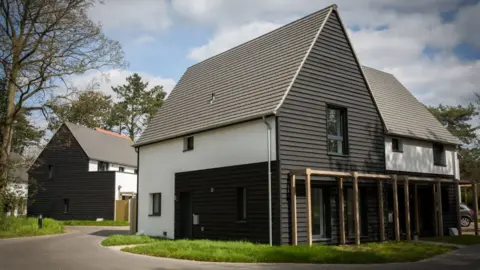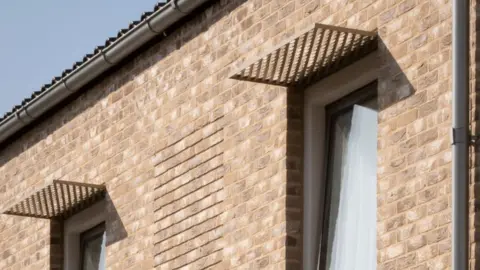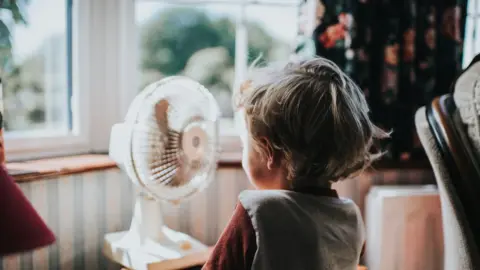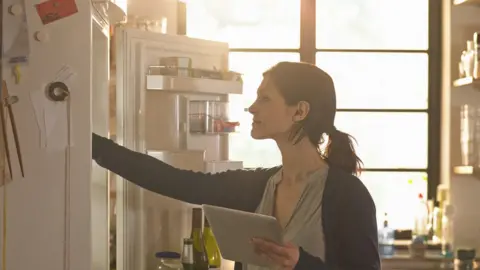
(Getty Images)
During the pandemic, up to 30% of people in the UK were working from home compared with 5% in 2019.
But it's hard to work if you live somewhere that becomes an oven in hot weather.
A UK government report into climate risks warned that unless homes can be kept cool in summer and warm in winter, health and productivity will suffer.

A development of new homes incorporating Passivhaus principles (Getty Images)
According to some forecasts, air conditioning alone could contribute to as much as a 0.5C increase in global warming by 2100.
The Passivhaus Trust works to promote buildings built to the Passivhaus standard, which means they are comfortable to live in while using very little energy for heating and cooling.
In 2019, the Stirling Prize for architecture went to Goldsmith Street in Norwich, a social housing scheme incorporating Passivhaus principles.
"Our existing housing stock is in many cases poorly prepared to deal with rising temperatures," said the Passivhaus Trust's John Palmer.
The government wants 300,000 new homes built every year, and Mr Palmer says they must be designed to cope with the heat without using energy consuming air-conditioning.
Cool shade
Good insulation won't stop a home being cool in summer, Mr Palmer says, but it will keep it warm in winter.
In hot weather very little heat is transmitted through the walls, the leading source of heat in temperate climates is usually sunlight through the windows.
"One metre square of south-facing solar glazing can generate 150 watts worth of heat," he said.
Some hi-tech glass has what's called a low g-value, meaning less heat from the sun passes through. But while this is useful in summer, in winter it means homes are colder.
Mr Palmer thinks it is better to use outside shutters, or overhangs that provide shade in summer but don't block light in winter when the sun hangs low in the sky.

Goldsmith Street features overhangs that provide shade above windows (Getty Images)
Buildings should ideally have windows orientated north-south, the Trust argues, with those on the north prioritising daylight, while glazing should cover less than a quarter of the property's south face.
A challenge, perhaps, when many of us crave sunshine.
Summer breeze
Windows provide ventilation as well as light.
Anastasia Mylona - head of research at the Chartered Institute of Building Service Engineers. has been particularly concerned about poor design in flats.
Cross-ventilation, where air flows between windows on opposite walls, is very important in keeping a property cool, says Ms Mylona.
But she says many "single-aspect" flats being built in urban centres have extensive glazing on one wall only, admitting heat but not allowing it to flow out.

Air moving through a home helps cool it (Getty Images)
She also said housing pressures mean new homes are often built near noise sources, for example close to railways or busy roads. Residents then face an impossible choice between cool and quiet, particularly at night.
Mr Palmer says it's important to appreciate how the air temperature will change over 24 hours. On the day we speak, he says his local forecast is for 25C during the day and 15C at night.
The trick, in summer, is to bring the cool night air inside and keep it cold for as long as possible. Some mechanical ventilation systems can help - by using stale but cold night-time air leaving the property to cool the warm fresh air coming in.
Controlling the flow of hot and cold air in underfloor spaces is the aim of UK start-up AirEx.
The firm has made smart air-bricks; the ones you may see with holes in on the side of buildings.
Connected to the home's wi-fi, they use sensors and "smart algorithms" to respond to temperature, humidity and air quality.
In winter they help keep homes warm. In summer, AirEx hopes, the wi-fi-connected bricks can help keep homes cool.
Hot ice
Heat is also generated within a property.
Fridges are cold because they transfer heat from their inside to outside - the bigger the fridge the more it will heat up the house. A small fridge will generate much less heat, Mr Palmer says.

(Getty Images)
Hot water systems also generate heat, with tanks and pipes working like radiators that are on even in the hottest days.
Insulating pipes can help.
In one hot home previously visited by the BBC, a long stretch of uninsulated pipes in a corridor wall seemed to give off as much heat as a large conventional radiator.
Mr Palmer uses a heat pump to warm water to 42C, which, although cooler than usual, is warm enough for a shower and doesn't heat the house so much.
Cool moves
Heat pumps can be thought of as two-way fridges.
They cool a house by moving heat from the inside air outside, and can also warm a home by bringing heat in from the outside.
They are energy-efficient, although there are concerns that the refrigerants some contain are strong greenhouse gasses if they leak. However, the use of these gasses is being reduced.
A UK start-up called Ventive is putting heat pumps, mechanical ventilation and hot water together in a single box.
Its system is being piloted by Nottingham City Council as one element in efforts to make existing housing stock more energy-efficient.
To help make hot water, a heat pump takes heat from the air and transfers it to the water, Ventive's box uses that process to also provide cool air inside.
"Currently we are heating the water and cooling the air separately wasting the energy at both ends. Combining the two would improve efficiencies by over 50%," writes Tom Lipinski, Ventive's founder and technical director.
The box also contains a phase-change material, similar in principle to a big block of ice, that can act as a "heat battery" - storing heat as it melts and warms, and giving off heat as it cools and freezes.
It adds to the capacity of the system to drain heat during the day, and then release it outside into the cold night air.
And it contains an electrical battery, which means the heat and electricity can be stored when it's most efficient to do so, and be released when needed.